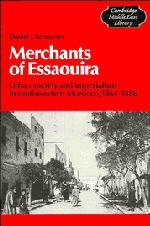Book contents
- Frontmatter
- Contents
- List of illustrations
- Map 1 General map of Morocco
- Preface
- Notes on usage
- Abbreviations
- Chronology
- 1 Introduction
- 2 The royal port
- 3 Merchants of the Sultan
- 4 Port and bazaar
- 5 Beyond the walls
- 6 The politics of trade
- 7 Foreign intervention and domestic reforms
- 8 The struggle for the southwest
- 9 The people of Essaouira in precolonial times
- 10 The end of an era
- Appendix A Corcos collection: nineteenth-century Arabic documents (1843–83)
- Appendix B Population estimates of Essaouira
- Appendix C Balancing revenue and expenditure: accounts of the port
- Appendix D Trade statistics for Essaouira
- Notes
- Bibliography
- Index
7 - Foreign intervention and domestic reforms
Published online by Cambridge University Press: 04 August 2010
- Frontmatter
- Contents
- List of illustrations
- Map 1 General map of Morocco
- Preface
- Notes on usage
- Abbreviations
- Chronology
- 1 Introduction
- 2 The royal port
- 3 Merchants of the Sultan
- 4 Port and bazaar
- 5 Beyond the walls
- 6 The politics of trade
- 7 Foreign intervention and domestic reforms
- 8 The struggle for the southwest
- 9 The people of Essaouira in precolonial times
- 10 The end of an era
- Appendix A Corcos collection: nineteenth-century Arabic documents (1843–83)
- Appendix B Population estimates of Essaouira
- Appendix C Balancing revenue and expenditure: accounts of the port
- Appendix D Trade statistics for Essaouira
- Notes
- Bibliography
- Index
Summary
In the decade following the Spanish Moroccan war of 1859–60, foreign intervention led to the transformation of the Moroccan state. Morocco was compelled to empty its treasuries to pay a war indemnity. There were insufficient funds to pay the Spanish, so payments continued for years to come. During the reign of Sīdī Muhammad b. ʿAbd ar-Rahmān (1859–73), Morocco attempted to consolidate its position. Administrative and fiscal reforms were initiated to increase the revenues of the makhzan in order to meet the costs of an expanding state apparatus.
War and indemnities
Soon after the peaceful succession of Sīdī Muhammad b. ʿAbd ar-Rahmān – proclaimed in Essaouira on 30 September 1859 – Morocco was threatened by a Spanish invasion. Domestic difficulties in Spain had pushed the Spanish government towards an imperialist adventure in Morocco. Agitation by the Rif tribes against the Spanish enclaves of Melilla and Ceuta provided the excuse for the invasion. The Spanish also considered invading Essaouira, which was still the most active seaport of Morocco. When attack on Essaouira appeared imminent, many Swiris began to flee the town, fearing a repetition of the events of 1844. Some of the elite left by sea for Gibraltar. About 220 Jews, mostly women and children, left on board a steamer with the departing British community.
- Type
- Chapter
- Information
- Merchants of EssaouiraUrban Society and Imperialism in Southwestern Morocco, 1844–1886, pp. 132 - 160Publisher: Cambridge University PressPrint publication year: 1988



